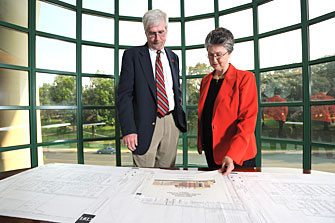Natural Products Research Center
receives funds for new building

Larry Walker and Barbara Wells
discuss construction plans for expanding the Thad Cochran Research
Center.
he University of Mississippi has
received $31.7 million to expand the Thad Cochran Research Center, the
primary research facility of the School of Pharmacy’s National Center
for Natural Products Research.
“It is exciting to see the achievement of this
milestone for Ole Miss and the School of Pharmacy,” said Larry A.
Walker, NCNPR’s director since 2001. “This is another major step toward
a world-class natural products research center, as envisioned by the
school’s leaders over two decades ago.”
The Health Resources and Services Administration
and the U.S. Food and Drug Administration are providing $17.8 million,
and the National Institutes of Health is providing $13.9 million.
Competition for the NIH funds was stiff, as each
qualifying institution was allowed to submit up to three proposals to
NIH’s Extramural Research Facilities Improvement Program. Under this
program to renovate or construct facilities supporting biomedical or
behavioral research, NIH made 63 awards totaling $675 million. UM’s pharmacy school is the only Mississippi recipient and the nation’s
only pharmacy school to receive an award from this program.
‘We are especially grateful to Sen. Thad Cochran
and his staff for their support throughout the years in obtaining
funding for this building.’
Larry Walker
Designed for research involving discovery of
natural products for pharmaceutical and agricultural commercialization,
construction of NCNPR’s first phase began in 1992 with USDA funds
appropriated by Congress. Personnel occupied the partially completed
facility in 1995, and this 115,000-square-foot building was completed
in 2000.
The existing facility includes auditoriums, a
science library, vivarium and repository for botanical specimens, as
well as sophisticated laboratories. All enabled the center’s research
programs to grow steadily and its scientists to build a reputation for
advancing natural products research. It also opened doors to additional
funding opportunities.
The second building will complete the NCNPR
complex and enable researchers to translate basic research into
clinical studies and commercial natural products. Its amenities will
include a facility for clinical studies, an expanded specimen
repository and laboratories for scaling-up extraction and synthesis of
bulk natural products, determining a natural product’s toxicity and
mechanism of action at the cellular level, and discovering microbial
and marine natural products. It also includes Good Laboratory
Practice-compliant analytical facilities and Good Manufacturing
Practice-compliant facilities for producing, formulating and
characterizing active pharmaceutical agents.
“Completion of the center envisioned so long ago
is finally within our grasp,” said Barbara G. Wells, the school’s dean.
“This second research building will allow us to advance our research
programs to the next level of accomplishment.”
Secured by Wells and Charles D. Hufford, the
school’s associate dean, the HRSA grant was to begin Phase II of NCNPR
in 2010 with a four-story superstructure with only one-and-a-half
floors completed. But as time for construction began, President Barack
Obama signed the American Recovery and Reinvestment Act, which provided
NIH with $5 billion to create jobs while expanding research. Since the
Phase II design was already complete, Walker and Hufford submitted a
proposal to NIH, describing how ARRA funding, coupled with the HRSA
funding, would enable the entire facility to be completed in a single
construction project.
“We are especially grateful to Sen. Thad Cochran
and his staff for their support throughout the years in obtaining
funding for this building, and we are also grateful to our dedicated
researchers who made the NIH proposal highly competitive,” Walker said.
Designed and engineered by Cook, Douglas, Farr and
Lemons of Jackson, Phase II plans are undergoing thorough reviews by
both HRSA and NIH. Construction is expected to begin in early 2011 and
to be completed by summer 2013.
“There are so many people to thank, in addition to
Sen. Cochran and Drs. Walker and Hufford,” Wells said. “Among
them are Dr. Alice Clark (UM’s chief research officer) and Dr. Leigh
Ann Ross (Pharmacy’s associate dean for clinical affairs), both of whom
have been strong advocates for this facility. Without their tenacity
and vision, this accomplishment would have been impossible.”
|

